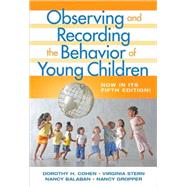
| Preface to the Fifth Edition | p. ix |
| Getting Started | p. 1 |
| Why Records? | p. 1 |
| Keeping Records | p. 6 |
| Language as a Tool in Recording | p. 10 |
| Importance of the Environment | p. 13 |
| Recording a Child's Behavior During Routines | p. 15 |
| Organizing the Information | p. 15 |
| The Meaning of Routines to Young Children | p. 19 |
| Recording Eating Behavior | p. 21 |
| Recording Toileting Behavior | p. 24 |
| Recording Behavior at Nap Time | p. 26 |
| Recording Behavior During Transitions | p. 28 |
| Patterns of Behavior | p. 29 |
| Recording a Child's Use of Materials | p. 34 |
| The Meaning of Materials to Young Children | p. 34 |
| What to Observe | p. 40 |
| Records of Use of Materials | p. 42 |
| How the Child Does What | p. 43 |
| Records Illustrating Detail | p. 46 |
| Interpretation-The Last Dimension | p. 49 |
| Patterns of Behavior | p. 49 |
| Recording Children's Behavior with One Another | p. 53 |
| How Children Learn to Socialize | p. 53 |
| Do We Really See What Is Going On? | p. 57 |
| What to Observe | p. 59 |
| Patterns of Behavior: Summary of a Child's Response to Other Children | p. 65 |
| Group Membership | p. 67 |
| Recording Children's Behavior in Dramatic Play | p. 70 |
| Capacity for Symbolic Representation | p. 72 |
| A Framework for Recording Dramatic Play | p. 77 |
| Focusing on Dramatic Roles | p. 81 |
| Social Aspects of Dramatic Play | p. 87 |
| Patterns of Behavior | p. 94 |
| Recording the Child's Relationships with Adults and in Adult-Directed Activities | p. 96 |
| Teachers Observe Themselves | p. 96 |
| Recording a Child's Interaction with an Adult | p. 97 |
| Gaining Information About a Child's Larger Social World | p. 102 |
| Recording a Child in Teacher-Directed Group Activities | p. 104 |
| Patterns of Behavior | p. 107 |
| Clues to Cognitive Functioning: Developmental Approach | p. 110 |
| How Do Children Learn? | p. 110 |
| Developmental Approach to Thinking in Early Childhood | p. 112 |
| How Can We Know a Child's Approach to Thinking? | p. 116 |
| Clues to Cognitive Functioning: Individual Approach | p. 128 |
| Idiosyncratic Approach to Thinking | p. 128 |
| How Much Does a Child Know? | p. 138 |
| Observing Children Develop the Power to Think | p. 142 |
| Forming Generalizations | p. 142 |
| Ability to Differentiate | p. 143 |
| Ability to Perceive Similarities and Differences | p. 144 |
| Ability to Draw Analogies | p. 144 |
| Ability to Perceive Cause and Effect | p. 145 |
| Time Orientation | p. 146 |
| Ability to Classify | p. 147 |
| Perceiving Patterns | p. 148 |
| Understanding Spatial Relationships | p. 149 |
| Recording Children's Developing Language and Emerging Literacy | p. 152 |
| Language and Culture | p. 152 |
| Recording Children's Use of Language | p. 154 |
| Observing Speech Patterns | p. 164 |
| Observing Emergent Literacy | p. 170 |
| Observing and Recording the Behavior of Infants and Toddlers | p. 172 |
| Making Sense of What You See | p. 172 |
| The Value of Recording | p. 173 |
| Time | p. 174 |
| What to Observe | p. 175 |
| Recording the Behavior of Children for Whom There Are Special Concerns | p. 205 |
| Sensory Reactivity and Self-Regulation | p. 207 |
| General Impression | p. 223 |
| Patterns-Summary-and Interpretation | p. 225 |
| Patterns | p. 225 |
| Features of the Final Summary | p. 228 |
| Interpretation | p. 233 |
| Final Summary | p. 235 |
| References | p. 239 |
| Index | p. 245 |
| About the Authors | p. 253 |
| Table of Contents provided by Ingram. All Rights Reserved. |
The New copy of this book will include any supplemental materials advertised. Please check the title of the book to determine if it should include any access cards, study guides, lab manuals, CDs, etc.
The Used, Rental and eBook copies of this book are not guaranteed to include any supplemental materials. Typically, only the book itself is included. This is true even if the title states it includes any access cards, study guides, lab manuals, CDs, etc.